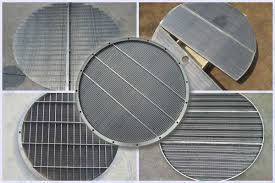
Filter mesh screens for Refinery oil and gas filtration operations
Filter screens are designed to handle different flow rates to provide continuous operations commonly in refinery applications. Hot streams of flurry oil frequently need removal of catalyst and other particulate. This not just improves oil quality, even also enhances downstream service equipment by preventing fouling and limiting maintenance.
Refinery
An objective for removing catalyst is enhancing the product fuel oils to supply feedstock for the production of carbon black, needle coke, feed, bunker oil and others. Eliminating the catalyst fins also decreases wear of downstream components due to the abrasive particles, prevents deposition and sludge development in slurry oil storage tanks besides to concerns for the hazardous waste classification of catalyst containing tank sediments.
Standard filtration system and backwash operation
Filtration is performed by using high quality filter system comprising of two filter containers, backwash receiver and a stabilizer tank. The filter vessels contain a cylindrical mesh filter screens that are installed from bottom to top. These screens are usually made of SS316L grade however other alloys can also be used depending on the application vigorousness. These separable filter screens are threaded into the vessel tube sheet. The equipment is designed for uninterrupted operation with both filters online except when one vessel is offline for backwash. The backwash receiver offers large volume to handle backwashes and is made to hold two backwashes.
Subsequent to filtration, filter backwash is conducted by stopping the feed stream and separating the filter element vessel. The filtrate in the shell can be displaced with backwash fluid usually a cycle oil. The vessel is pressured with nitrogen or gas from the stabilizer tank to attain a backwash pressure. The bottom discharge valve is opened and applied pressure drop and reverse flow through the filter elements dislodges the cake and vessel drains to the backwash receiver. Once backwash is complete, filter is ready for use again. The backwash slurry containing 15 to 20% solids, is pressurized at a controlled flow rate to the riser, or can be sent to an asphalt plant or a settling tank.
Features of filtration mesh
Nominal maintenance: Porous metal mesh has no moving components, resulting in easier and less frequent maintenance procedures.
Reduced expense: Porous metal filter mesh seldom requires replacement
High strength filter mesh: Sintering bonds filter media at the molecular level has high mechanical resistance in compression and stress.
Decreased waste production: Easy to clean filter elements prevent the need of incineration or landfills which occur with disposable filters.
Uniform and high precision mesh: These filter mesh screens have a controlled pore size and pore distribution to create filtration media with distinct porosity properties.
High temperature corrosion resistance: Sintered mesh screens are resistant to high temperatures and corrosive conditions, hence are suitable for a large range of applications.
Backwash filter mesh decrease exposure of operator to hazardous chemicals hence they create a safe working atmosphere and are easy to use.
Porous sintered mesh filter elements are offered with a large selection of specifications from standard to customized ranges and are produced in different materials such as stainless steel 316 and corrosion resistant nickel and Hastelloy grades.
